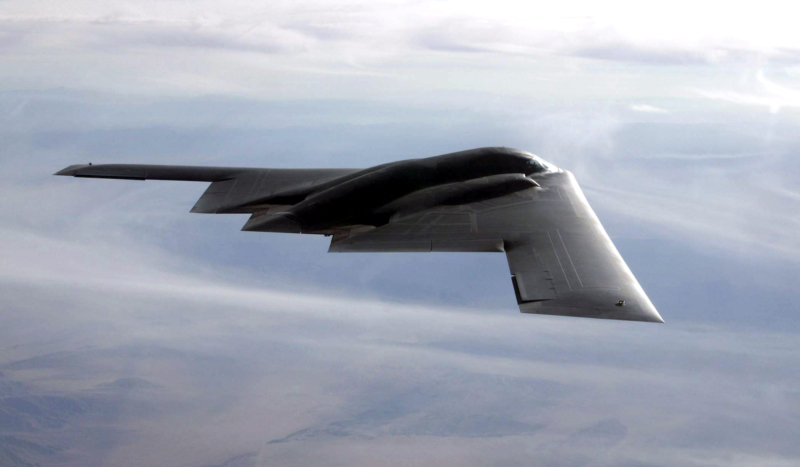
The B-2 flies over the Utah Testing and Training Range at Hill Air Force Base, Utah, during a test run. (US Air Force Photo by Bobbie Garcia)
President Donald Trump indicated on social media that he is open to “regime change” in Iran, hours after Defense Secretary Pete Hegseth told reporters that the United States’ strikes on Iranian nuclear sites were not “about regime change.”
“It’s not politically correct to use the term, ‘Regime Change,'” Trump wrote Sunday evening, “but if the current Iranian Regime is unable to MAKE IRAN GREAT AGAIN, why wouldn’t there be a Regime change??? MIGA!!!”

According to Hegseth, Trump ordered the US military’s precision strike against three nuclear facilities in Iran only “in order to destroy or degrade Iran’s nuclear program,” and not to target Iranian troops or Iranian people.
“This mission was not and has not been about regime change,” Hegseth said, according to the transcript of a Pentagon press briefing posted on the US Department of Defense’s website. “The president authorized a precision operation to neutralize the threats to our national interests posed by the Iranian nuclear program and the collective self-defense of our troops and our ally Israel.”
As CatholicVote previously reported, Trump said in a June 21 address after announcing on Truth Social that the US had made the strikes that if there is no peace, “there will be tragedy for Iran, far greater than we have witnessed over the last eight days.”
Hegseth said in the press conference that Trump has insisted — for more than a decade — that Iran must not get a nuclear weapon. He explained that Trump “was fully committed to the peace process” and wanted Iran to negotiate terms where it would give up its nuclear program. That didn’t happen, so Trump “realized that it had to be a certain action taken in order to minimize the threat to us and our troops,” Hegseth said. He said Trump wants peace, not an open-ended war in the Middle East.
Hegseth said that Trump has “made it very clear” that it reviewed all the military intelligence and concluded that the Iranian nuclear program is a threat.
“Thanks to President Trump’s bold and visionary leadership and his commitment to peace through strength, Iran’s nuclear ambitions have been obliterated,” Hegseth said.
According to Hegseth, the operation took months of planning and weeks of preparation and it demonstrated the return of “American deterrence.” The plan involved misdirection, operational security, and coordination with allies in Israel, he explained.
“The mission demonstrated to the world the level of joint and allied integration that speak to the strength of our alliance and our joint forces,” Hegseth said. “As President Trump has stated, the United States does not seek war, but let me be clear, we will act swiftly and decisively when our people, our partners or our interests are threatened. Iran should listen to the President of the United States and know that he means it, every word.”
Hegseth said that part of the operation was the defense of Israel but the US operated and led the strike. Gen. Dan Caine, the chairman of the Joint Chiefs of Staff, said the US and Israel made sure that they were not in the same airspace at the same time. Caine said that few American officials knew the details of the mission, Operation Midnight Hammer.
Caine said the US forces are unaware of any shots that were fired at the strike package of B-2 bombers, which launched midnight Friday from the continental US, during its entry and exit from Iranian airspace.
“Iran’s fighters did not fly, and it appears that Iran’s surface to air missile systems did not see us. Throughout the mission, we retained the element of surprise,” he said. “In total, U.S. forces employed approximately 75 precision guided weapons during this operation. This included, like the president stated last night, 14 30,000-pound GBU-57 Massive Ordnance Penetrators, marking the first ever operational use of this weapon.”
Preliminary battle damage assessments indicate every site “sustained extremely severe damage and destruction,” according to Caine. Final battle damage will take “some time” to complete, he explained.
Caine said Gen. Michael “Erik” Kurilla, the commander of the United States Central Command, has increased defense of service members and civilians in the region, particularly in Iraq, Syria, and the Gulf. Caine said forces in those areas did not receive advance warning that the attacks would occur and said the military “made smart decisions to minimize the risk to US forces in the region” based on how the risk of force had been rising recently.
Caine said, “Our forces remain on high alert and are fully postured to respond to any Iranian retaliation or proxy attacks, which would be an incredibly poor choice.”
Hegseth said Congress was notified “immediately” after the B-2 bombers exited Iran airspace, and he said that notification complied with the War Powers Act.
Hegseth said Iranians know what to do to make peace.
“And I think Tehran is certainly calculating the reality that planes flew from the middle of America and Missouri overnight, completely undetected over three of their most highly sensitive sites, and we were able to destroy nuclear capabilities,” he said. “And our boys in those bombers are on their way home right now. We believe that will have a clear psychological impact on how they view the future, and we certainly hope they take the path of negotiated peace.”
